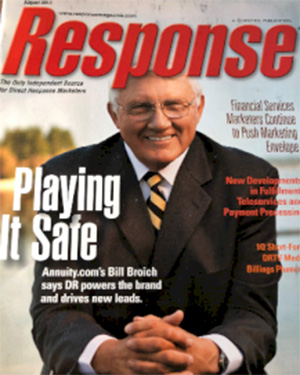
Article Library

Bill Broich
Annuity.com
E. 171 Okonek
Grapeview, Washington 98546
bbroich@msn.com
(360) 701-6209
$50 Trillion, And The Machine Rages.
While this may appear on the surface as a partisan political article, it truly is not. What I say about our politicians, regardless of party affiliation, is this: Once elected, the machine grabs them, and they all change; their election promises are rarely kept, and the machine eats them alive.
This editorial is about $50 trillion dollars.
Our current national debt is $31.5 trillion; we owe this money and are paying interest on it.
A recent report from the Congressional Budget Office reassessed debt projections for the next 10 years and increased their estimate of our additional debt - on top of our current debt. Please add another $19 trillion in deficit funding, bringing our total as a nation to $50 trillion.
$50 trillion and then this: The nation’s debt has been bigger than its gross domestic product for several years.
This is more than a mortgage on our future; it signifies a rope our politicians put around the neck of all of us, especially our children, and their children, and their children, et al.
The increased and growing debt is no longer an issue. We are beyond that. The problem is what will happen to U.S. citizens and our nation due to this debt. We have one topic we must hit head-on if we as individuals will survive the national debt and retirement. I won’t speak to health care quality, social security, and the need for government support; in this discussion, I will stick to money, primarily debt, and what it will bring. Inflation
In the past, our government has tracked inflation and used the Consumer Price Index (CPI) as the barometer of measurement. President Reagan changed that policy when he eliminated energy, and President Clinton removed more of the barometer by removing food from the calculation. This was done to make the analysis more manageable for the budget balancers. How can we adjust income when food and energy are removed from the standard?
Then, one of our presidents allowed the annual budget deficit to be lowered by transferring money from the Social Security fund to the U.S. Budget. How could that be justified? Simple, the government guarantees the payment of Social Security benefits, so it could be part of lowering the budget—another machine rage.
This accounts for 21.8% of the public debt, or $6.87 trillion, owned by another arm of the federal government. Plus, the Federal Reserve System is the single largest holder of U.S. government debt. This is called “intragovernmental holdings” in special non-traded Treasury securities.
Servicing the debt is one of the federal government’s most significant expenses. Net interest payments on the debt are estimated to total $395.5 billion this fiscal year.
Inflation is our enemy; over time, it will become our “mortal” enemy. As the cost of living increases and our income doesn’t, we are placed between a rock and a hard place. We are quickly running out of options. The machine rages on.
When planning on retirement, inflation MUST be at the core of planning. Each of us must make room in our budgets for additional living costs and the cost of these goods and services.
What if you cannot plan in time? What can you do? To be honest, not much, except to rely on contributions from friends, families, your community, your church, and the government.
Therein lies the problem and where the machine, like a predator lion, is lying in wait: retirees vote and need help. So what does the politician do? Provide more and more benefits and kick the problem down the road.
That is how you get to $50 trillion in national debt. Our lifelong pursuit of happiness, our country, our communities, and even our lives are at risk. It is the future of America as we know it; that is what is a stake.
We must unplug the machine.
Many people have learned about the power of using the Safe Money approach to reduce volatility. Our Safe Money Guide is in its 20th edition and is available for free.
It is an Instant Download. Here is a link to download our guide:

Best Tips
For A Worry-Free
Retirement
The Safe Money Guide